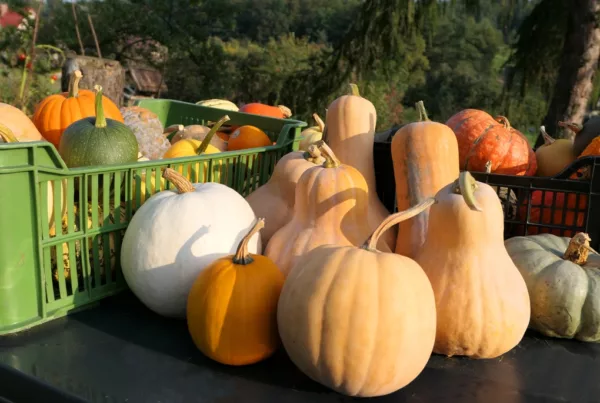Written by Kristina Hicks-Hamblin
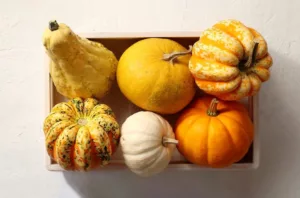 Whether you’ve grown an assortment this year or have your thoughts on next year’s plans, an abundant winter squash, gourd, or pumpkin harvest from your Square Foot Garden doesn’t have to be a spice-scented daydream – it can easily become a delicious and decorative reality!
Whether you’ve grown an assortment this year or have your thoughts on next year’s plans, an abundant winter squash, gourd, or pumpkin harvest from your Square Foot Garden doesn’t have to be a spice-scented daydream – it can easily become a delicious and decorative reality!
Let’s consider a few tips that will help you enjoy a plentiful harvest of these homegrown heralds of autumn.
Winter Squash, Pumpkin, or Gourd – What’s the Difference?
Winter squash, pumpkins, and gourds – these members of the cucurbit family are closely related, but have different purposes in our kitchens and homes. Before you decide what to grow in your raised beds, it will help to know what the fruits of these plants are used for!
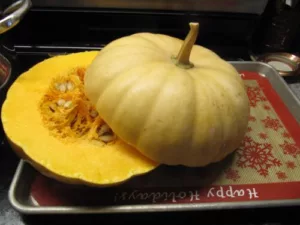
Photo by Alex Darc.
Pumpkins are often grown just for autumn decorations and jack-o-lantern carving, but can also be used to make delicious, spiced pies. With tiny to giant varieties, these orange fruits come in all sizes.
However, winter squash tends to be the best for use in the kitchen, with most cultivars having denser, richer, and less watery flesh. Colorful varieties make these prized for fall decorating as well.
Gourds are vining plants whose fruits can be dried to make a number of different handcrafted items, including bird houses, drinking vessels, scoops, sponges – and even musical instruments!
While the fruits of some gourds are edible when immature, some, such as bottle gourds, are toxic, so before you taste, check to see if the gourd you have grown is edible or not.
Sowing Seeds in the SFG for a Fall Harvest
Understandably, new Square Foot Gardeners might be mistaken by the term “winter squash,” thinking that they grow during the cold months. Alas, they don’t!
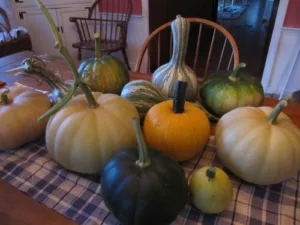
An assortment of winter squash.
Called “winter squash” because they store well during the cold months, these vegetables, as well as gourds and the very closely related pumpkins, are sown in spring after the last frost has passed.
Learn more about when to sow these crops with our planting chart cheat sheets!
Each of these crops requires a long, warm season of growing – and the bigger the fruit, the more warm days are needed.
So if you want to grow these colorful cucurbits for fall, find out how many days are in your growing season, and choose a variety that will ripen in time for an autumn gourd, squash, or pumpkin harvest.
Varieties for Vertical Gardening in SFG Beds
However, days to maturity is not all you’ll need to consider to ensure an enviable gourd, winter squash, or pumpkin harvest.
In the SFG Method, ideally vining plant varieties are grown vertically to create more room in the raised beds, and to keep the aisles around raised beds tidy. That means you’ll want to choose varieties that aren’t too heavy to be supported by trellises.
Here are some options that will work for most SFG trellises:
- This is a great one for baking or sauteing. ‘Climbing Honey Nut’ bears one-pound fruits that are russet colored with green mottling and have exceptional flavor and texture. Harvest in 110 days. ‘Climbing Honey Nut’ seeds are available at Renee’s Garden.
- Next up is a tiny option for decorating or baking. ‘Mini Jack’ miniature pumpkins are lightweight, just three to four inches wide. They look adorable as decorations, but can also be cooked up. A great option for short growing seasons, these need just 80-85 days to mature. Buy ‘Mini Jack’ seeds at Renee’s Garden.
- Grow your own sponges! ‘Bath Loofah’ (also known as “luffas”) are gourds that can be used as bath sponges when grown to full size, but are edible when picked small. These gourds need 110 days of warm weather to reach maturity. You’ll find ‘Bath Loofah’ seeds at Renee’s Garden.
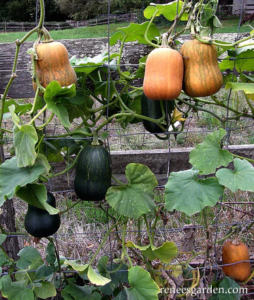
‘Climbing Honey Nut’
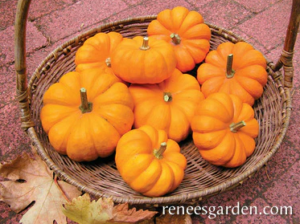
‘Mini Jack’
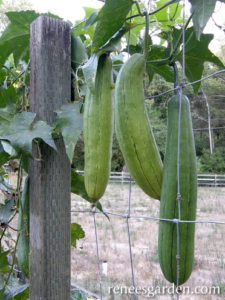
‘Bath Loofah’
Harvest, Store, and Enjoy Your Cucurbit Crop
When fall weather starts to cool, it’s time to harvest pumpkins, gourds, and winter squash.
To check for maturity, try scratching the rind with your fingernail – fully ripened fruits have hard rinds. The vines of the plants may also start to die back when fruits are ripe.
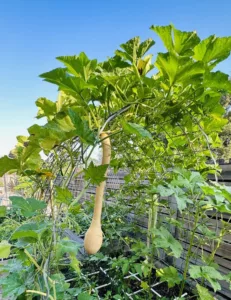
Winter squash ripening on the vine in the SFG.
However, if you have a freeze coming on and no winter protection for your plants, go ahead and pick these veggies whether ripe or not.
Cut the fruits off of their vines leaving a few inches of stem attached, but don’t lift the cucurbits by this handle. Allow pumpkins and winter squash to cure in the sun for a few days, but bring them inside if you have rain or frost.
Harvested pumpkins and winter squash can be stored to serve as a winter food supply. Place them in a cool, dry location above 50°F for best keeping.
Also, consider storing them on a layer of newspapers or cardboard in case of spoilage.
If using your cucurbits for decorations whether indoors or outdoors, know that they won’t keep as long in hot or below freezing conditions.
And don’t forget that gorgeous as they are, pumpkins and winter squash make excellent food!
My personal favorite way to use these veggies is to bake peeled slices with fresh cranberries and roasted chestnuts. Sprinkle with a little sage from your SFG herb bed, serve with brown rice, and you’re all set for a savory autumn meal!
Looking for more ideas for baked pumpkin or winter squash? Just add spice.



